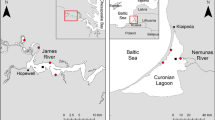Abstract
The settling flux of seston (dry weight, DW), chlorophyll a (Chl a), particulate organic carbon (POC), particulate organic nitrogen (PON), and particulate phosphorus (PP) was measured monthly in 1981–1983 at 10 different depths in Lake Chuzenji, Japan; an oligotrophic lake with a maximum depth of 163 m. The Ti concentration in entrapped matter was used to separate the sedimentation flux into allochthonous and autochthonous components. Inflow loads of dissolved nutrients (DN: 4.5, DP: 0.48 g m-2a-1) were almost sufficient to supply the autochthonous fluxes at 30 m (PON: 2.9, PP: 0.51 g m-2a-1 ), and this flux of POC (26.6 g m-2a -1) was about one-third of primary production (84 g C M-2a-1). Sedimentation of particulate matter was the main path of losing nutrients from lake water, explaining more than 80% removal of inflow loads (TN, TP). Decomposition rates during sedimentation which were calculated from the vertical difference in the autochthonous flux agreed very closely with the results obtained by laboratory experiments of a 100-day incubation (content ratios from field observations were: POC 0.67, PON 0.65, PP 0.85; and from laboratory experiments they were: POC 0.68, PON 0.70, PP 0.94). These decomposition rates and those near the sediment interface were used to explain dissolved oxygen depletion and nitrate increase in the hypolimnion during stratification. The average sinking velocities were 1.82m d-1 for seston and 1.16 m d-1 for Chl a at 30m, they were influenced by Chl a content of seston.
Similar content being viewed by others
References
Aizaki, M. & A. Otsuki, 1984a. Characteristics of water quality in Lake Chuzenji. Res. Rep. Natl. Environ. Stud. 69: 37–51. (in Japanese)
Aizaiki, M., K. Muraoka, T. Hirata, T. Fukushima, S. Iwata, S. Ebise, K. Otsubo & A. Otsuki, 1984b. Nutrients budget in Lake Chuzenji. Res. Rep. Natl. Environ. Stud. 69: 99–112. (in Japanese)
Bloesch, J. & N. M. Burns, 1980. A critical review of sedimentation trap technique. Schweiz. Z. Hydrol. 42: 15–55.
Bloesch, J., P. Stadelmann & H. Buhrer, 1977. Primary production, mineralization, and sedimentation in the euphotic zone of Swiss lakes. Limnol. Oceanogr. 22: 511–526.
Bloesch, J. & M. Sturm, 1986. Settling flux and sinking velocities of particulate phosphorus (PP) and particulate organic carbon (POC) in Lake Zug, Switzerland. In: Sediments and Water Interactions. Ed. P. G. Sly, Springer-Verlag: 481–490.
Bowen, H. J. M., 1979. Environmental chemistry of the elements. Academic Press, 333 pp.
Davis, M. B., 1968. Pollen grains in lake sediments. Science 162: 796–799.
Fallon, R. D. & T. D. Brock, 1980. Planktonic blue-green algae: Production, sedimentation, and decomposition in Lake Mendota, Wisconsin. Limnol. Oceanogr. 25: 72–88.
Fukushima, T., M. Aizaki & K. Muraoka, 1984. Characteristics of deposited matter at Takahamairi Bay in Lake Kasumigaura. Res. Rep. Natl. Inst. Environ. Stud. 51: 73–87. (in Japanese)
Gardner, W. D., 1980. Sediment trap dynamics and calibration: a laboratory evaluation. J. mar. Res. 38: 17–39.
Gasith, A., 1975. Tripton sedimentation in eutrophic lake. Verb. Int. Ver. Limnol. 19: 116–122.
Hargrave, B. T., 1969. Similarity of oxygen uptake by benthic communities. Limnol. Oceanogr. 14: 801–805.
Hirata, T. & K. Muraoka, 1984. Thermal stratification and internal waves in Lake Chuzenji. Res. Rep. Natl. Inst. Environ. Stud. 69: 5–35. (in Japanese)
Jassby, A. & T. Powell, 1975. Vertical patterns of eddy diffusion during stratification in Castle Lake, California. Limnol. Oceanogr. 20: 530–543.
Koyama, T., K. Matsunaga & T. Tomino, 1975. Geochemical studies on the cycle of carbon and nitrogen in a mesotrophic lake. JIBP Synthesis 12: 115–123.
Koyama, T., 1980. Biochemistry. Tokai Univ. Press: 258 pp. (in Japanese)
Lastein, E., 1976. Recent sedimentation and resuspension of organic matter in eutrophic Lake Esrom, Denmark. OIKOS 27: 44–49.
Matsunaga, K., 1981. Studies on the decompositive processes of phytoplanktonic organic matter. Jap. J. Limnol. 42: 220–229.
Matsunaga, K., 1982. An estimation of allochthonous and autochthonous organic matter of the fresh sediments on the basis of Ti content. Jap. J. Limnol. 43: 113–120.
OECD, 1982. Eutrophication of waters. OECD Paris: 154 pp.
Okamoto, K. & K. Fuwa, 1984. Low-contamination digestion bomb method using a teflon double vessel for biological materials. Analyt. Chem. 56: 1758–1760.
Pennington, W., 1974. Seston and sediment formation in five Lake District lakes. J. Ecol. 62: 215–251.
Smayda, T. J., 1970. The suspension and sinking of phytoplankton in the sea. Oceanogr. Mar. Biol. Annu. Rev. 8: 353–414.
Smayda, T. J., 1974. Some experiments on the sinking characteristics of two freshwater diatoms. Limnol. Oceanogr. 19: 628–635.
Takamatsu, T., 1978. Multi-element analyses of rock and sediment samples by non-dispersive X-ray fluorescence. Bunseki Kagaku 27: 193–198. (in Japanese)
Titman, D. & P. Kilham, 1976. Sinking in freshwater phytoplankton. Limnol. Oceanogr. 21: 409–417.
UNESCO, 1966. Determination of photosynthetic pigments in seawater. Monographs on Oceanographic Methodology 1. UNESCO Pub. Cen.: 69 pp.
Author information
Authors and Affiliations
Rights and permissions
About this article
Cite this article
Fukushima, T., Aizaki, M. & Muraoka, K. Characteristics of settling matter and its role in nutrient cycles in a deep oligotrophic lake. Hydrobiologia 176, 279–295 (1989). https://doi.org/10.1007/BF00026562
Issue Date:
DOI: https://doi.org/10.1007/BF00026562




